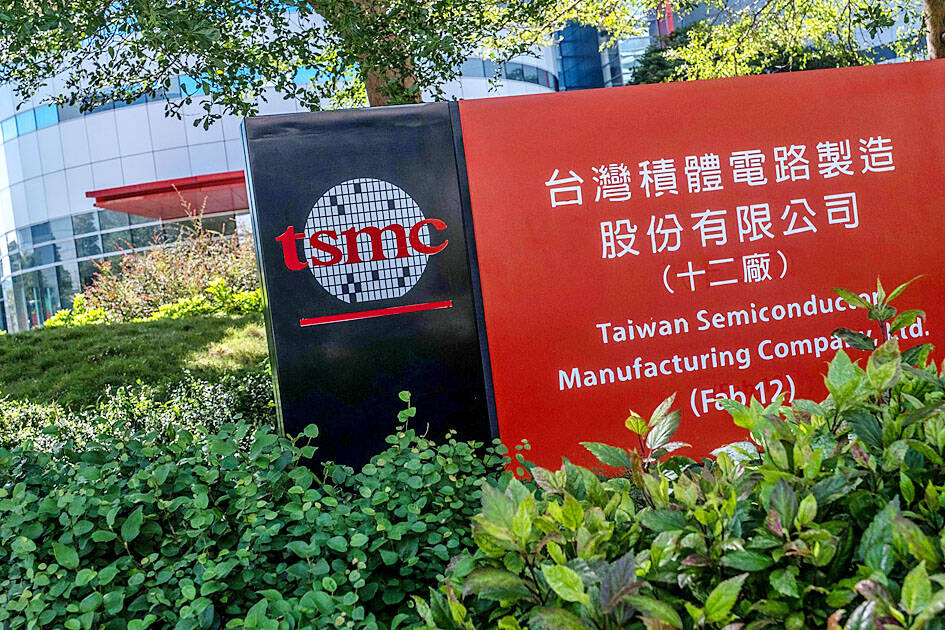Taiwan Semiconductor Manufacturing Co (TSMC, 台積電) yesterday slashed its capital spending by up to 18 percent for this year to US$36 billion, as sluggish demand for smartphones and PC’s curtailed demand for its 7-nanometer chips and lowered capacity utilization.
Demand for its chips also dwindled as customers continued digesting excessive inventory, the world’s largest contract chipmaker told a virtual investor conference. The inventory correction is expected to carry through the first half of next year, leading to a reduction in TSMC’s factory utilization during the period, the company said.
In response to softness in medium-term demand outlook, TSMC is tightening capital spending budget for this year, it said.

Photo: Lam Yik Fei, Bloomberg
TSMC in July was set to spend between US$40 billion and US$44 billion on new facilities and equipment, but a bulk of this year’s capital expenditures are to focus on advanced technologies expansion, it said.
In its efforts to optimize capacity, the chipmaker said it also adjusted its 7-nanometer chip capacity expansion at its Kaohsiung facilities, but it would continue bundling new 28-nanometer chip capacity at the site as scheduled.
“Starting the fourth quarter this year, our 7-nanometer and 6-nanometer capacity utilization will not be as high as it has been in the past three years. We expect this to persist for a few quarters through the first half of 2023,” TSMC CEO C.C. Wei (魏哲家) said.
Most of TSMC’s 7-nanometer and 6-nanometer chips are used in smartphones and computers, Wei said, adding that customers are pushing back new product schedules, causing a slide in demand.
“Probably in 2023, the semiconductor industry will likely decline, but TSMC also is not immune,” Wei said. “Our business will be more resilient than the overall semi industry.”
Next year is expected to be a growth year for TSMC next year, following a 35 percent year-on-year growth in revenue this year, he said.
Manufacturing tool delivery challenges are also a major factor behind TSMC’s cuts to capital spending this year, particularly with photolithography tools, Wei said.
TSMC is to be “more conservative” about new capacity planning next year, as market demand has become so weak that there is a likelihood that a further business correction could take place next quarter, Wei said, adding that data center and automotive-related applications remain steady.
TSMC yesterday maintained an unchanged revenue growth target of an annual compound growth rate of between 15 percent and 20 percent over the next few years.
In response to investors’ concerns regarding the US’ latest semiconductor export restrictions to China, Wei said “the new regulation sets the control threshold at a very high-end specification, which is primarily used for artificial intelligence, or supercomputing applications. Therefore, our initial assessment of the impact on TSMC is limited and manageable.”
TSMC said it has been granted a one-year license to expand 28-nanometer and 16-nanometer chips at its China fab in Nanjing. China accounted for 8 percent of TSMC’s revenue last quarter, down from 13 percent in the previous quarter.
TSMC yesterday posted a record-high quarterly net profit of NT$280.87 billion (US$8.81 billion), up 18.5 percent quarter-on-quarter, or annual growth of 79.7 percent.
Gross margin surged to 60.4 percent last quarter from 59.1 percent in the second quarter, and 51.3 percent in the third quarter last year.
Looking forward, revenue this quarter is expected to be little changed, at a range from US$19.9 billion to US$20.7 billion, compared with US$20.23 billion last quarter, it said, adding that demand for 5-nanometer and 28-nanometer chips are robust.
Gross margin is to be between 59.5 percent and 61.5 percent, TSMC said.
When asked whether TSMC would accelerate capacity expansion overseas to cope with rising geopolitical tensions, Wei said the company would increase “overseas portions of manufacturing based on customers’ needs, business opportunity, operation efficiency and cost economics.”
The company is evaluating whether to build a new fab in Europe, Wei said.

SECURITY: As China is ‘reshaping’ Hong Kong’s population, Taiwan must raise the eligibility threshold for applications from Hong Kongers, Chiu Chui-cheng said When Hong Kong and Macau citizens apply for residency in Taiwan, it would be under a new category that includes a “national security observation period,” Mainland Affairs Council (MAC) Minister Chiu Chui-cheng (邱垂正) said yesterday. President William Lai (賴清德) on March 13 announced 17 strategies to counter China’s aggression toward Taiwan, including incorporating national security considerations into the review process for residency applications from Hong Kong and Macau citizens. The situation in Hong Kong is constantly changing, Chiu said to media yesterday on the sidelines of the Taipei Technology Run hosted by the Taipei Neihu Technology Park Development Association. With

CARROT AND STICK: While unrelenting in its military threats, China attracted nearly 40,000 Taiwanese to over 400 business events last year Nearly 40,000 Taiwanese last year joined industry events in China, such as conferences and trade fairs, supported by the Chinese government, a study showed yesterday, as Beijing ramps up a charm offensive toward Taipei alongside military pressure. China has long taken a carrot-and-stick approach to Taiwan, threatening it with the prospect of military action while reaching out to those it believes are amenable to Beijing’s point of view. Taiwanese security officials are wary of what they see as Beijing’s influence campaigns to sway public opinion after Taipei and Beijing gradually resumed travel links halted by the COVID-19 pandemic, but the scale of

A US Marine Corps regiment equipped with Naval Strike Missiles (NSM) is set to participate in the upcoming Balikatan 25 exercise in the Luzon Strait, marking the system’s first-ever deployment in the Philippines. US and Philippine officials have separately confirmed that the Navy Marine Expeditionary Ship Interdiction System (NMESIS) — the mobile launch platform for the Naval Strike Missile — would take part in the joint exercise. The missiles are being deployed to “a strategic first island chain chokepoint” in the waters between Taiwan proper and the Philippines, US-based Naval News reported. “The Luzon Strait and Bashi Channel represent a critical access

Pope Francis is be laid to rest on Saturday after lying in state for three days in St Peter’s Basilica, where the faithful are expected to flock to pay their respects to history’s first Latin American pontiff. The cardinals met yesterday in the Vatican’s synod hall to chart the next steps before a conclave begins to choose Francis’ successor, as condolences poured in from around the world. According to current norms, the conclave must begin between May 5 and 10. The cardinals set the funeral for Saturday at 10am in St Peter’s Square, to be celebrated by the dean of the College